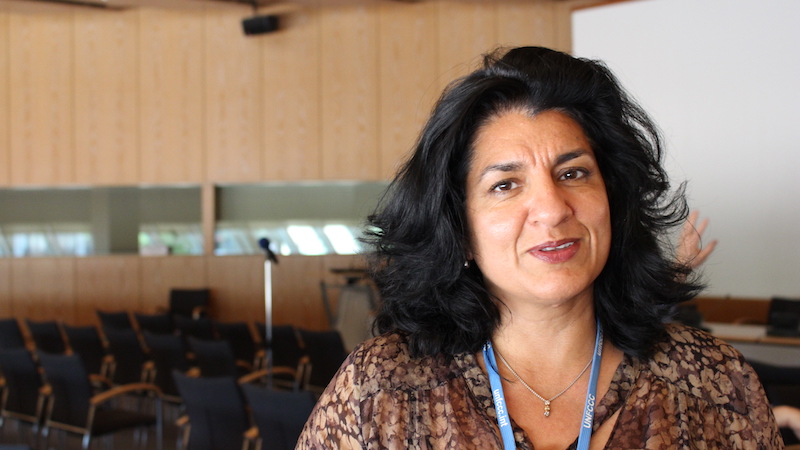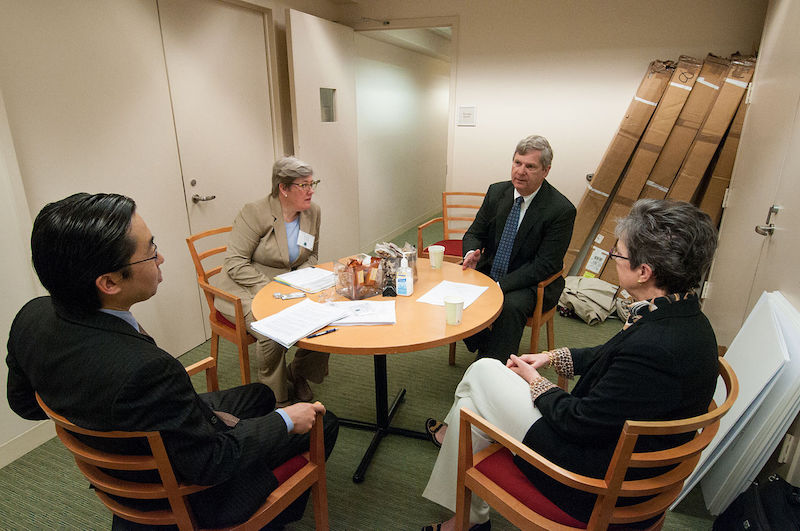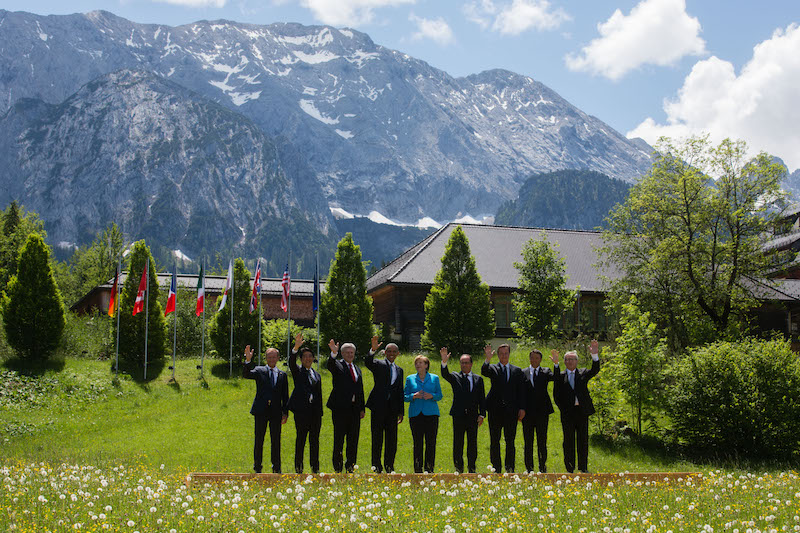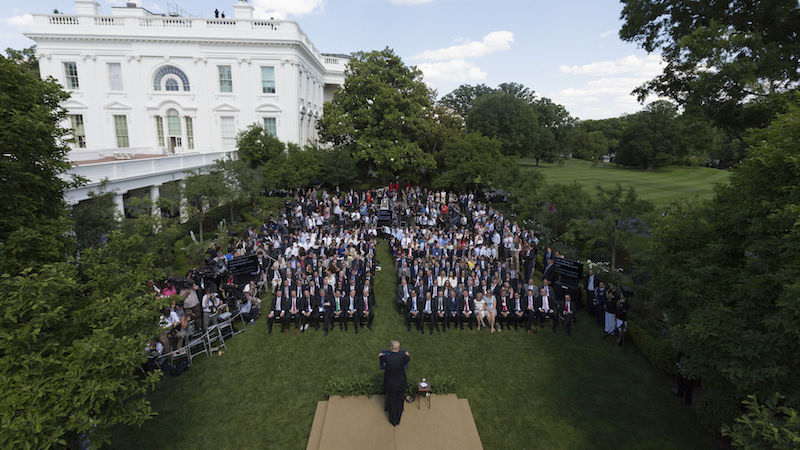In 2013, a group of women sat around the kitchen table at Glen House, a country estate in the Scottish borders.
Farhana Yamin, one of the lead organisers, describes them as “lionesses”: a pride of around 30 lawyers, diplomats, financiers and activists on a mission to halt dangerous climate change.
Not least among them was Christiana Figueres, head of the UN climate body, responsible for getting a just, ambitious and effective international pact at the upcoming 2015 Paris summit. Nobody wanted to see a repeat of Copenhagen 2009, where talks collapsed.
This idyllic retreat at the home of green finance pioneer Tessa Tennant, who died in 2018, was a testing ground for many elements of the Paris Agreement. These included a concept that is fast becoming the guiding principle of climate action: net zero emissions.
“There had been discussions about what should be the long-term goal of the UN regime for a long time, going right back to the early days. We had umpteen takes,” says Yamin, a veteran of the process.

Farhana Yamin at Chatham House, where she is an associate fellow (Photo: Adopt A Negotiator)
Net zero was the idea that emerged and is now being translated into national laws, urban strategies and business plans among would-be climate leaders.
UN chief Antonio Guterres has adopted carbon neutrality by 2050 as the benchmark for ambition ahead of his climate summit in New York on 23 September. Even as the political coalition behind Paris fragments, with backsliding from the US, Australia, Brazil, activists are calling for zero with fresh urgency and analysts mapping out how to make it happen.
It is not without problems. No major emerging economy is ready to embrace the absolutism of a greenhouse gas phaseout. The “net” in “net zero” masks a range of loopholes. But it brings a clarity to the issue that was previously lacking.
There was an informal consensus around 2C as a threshold for dangerous global warming. Small island states, whom Yamin advised over much of her career, argued a tougher 1.5C limit was essential to their survival – it was their die-in-the-ditch issue in Copenhagen.
While those temperature goals would find a place in the Paris Agreement, neither readily translated into workable emissions targets.
“When I reflected on why Copenhagen failed, I came to the conclusion… we needed a more concrete, practical measure,” says Yamin.
Some experts focused on the concentrations of CO2 in the air, others advocated personal carbon budgets that would “contract and converge” until the world’s rich and poor were on the same level. Taking inspiration from the Montreal Protocol, the treaty to phase out ozone-depleting CFCs, Yamin plumped for the simplicity and universality of zero emissions. “Once people get their heads round this scary idea, they enjoy having this constraint and something to work towards.”
Yamin went on to set up Track0 to mobilise support. While a handful of men get credit in her account, she keeps returning to how this informal network of women drove the campaign in their various spheres of influence, reinforcing one another’s conviction. “There are many mothers of this goal,” she says.
It was at Glen House that the net zero target won some important backers. For Rachel Kyte, the gathering was a pivotal moment. She digs out a photo of her son playing on the lawn to check the timestamp – 3 August 2013.
As a climate envoy for the World Bank, she was one of the most sceptical voices at the table. “There were a lot of mainstream thinkers who were really horrified and put off by the whole idea,” she says. “I was in the middle of the international financial complex at the time. I was throwing up the dust you would expect to get: how are you going to stitch together the money and support for developing countries and all the rest of it.”
Want to meet some of the key architects of the climate regime? Join Rachel Kyte, Farhana Yamin and others in New York for a very special CHN event on Wednesday 25th September. Register here for your free ticket.
There was a heated debate over whether long-term targets were useful at all, or a distraction from short-term action.
Then came questions about whether “net zero” gave too much wiggle room to delay emissions cuts and rely on sucking carbon dioxide out of the air. It was a full five years before the International Panel on Climate Change special report on 1.5C would show the tougher target was only feasible with some level of negative emissions.
Over a series of “really profound conversations”, Kyte came round to a new way of thinking, which she took back to the bank. The following year its chief Jim Kim declared his support for a net zero emissions goal in the Paris Agreement.

Rachel Kyte, then World Bank vice president and special climate envoy, meets US officials at the White House (Photo: USDA)
While Kyte shifted the dial in Washington DC, Jennifer Morgan took up the campaign in Berlin. At the World Resources Institute (WRI), she was close to Angela Merkel’s administration.
“Having that kind of a long term goal was very important to give the certainty, particularly to the private sector, so they could plan and have a managed transition,” says Morgan.
Merkel got fellow G7 leaders to agree in June 2015 on the need for “decarbonisation of the global economy over the course of this century” – a key moment in the build-up to the Paris summit. It was “a huge fight” moving Japan and Canada towards that commitment, Morgan says.
Shortly after, Yamin recalls a split among the lionesses over what would count as victory in Paris. The network had more than doubled in size to include more youth and women from developing countries. Some members saw 2C as the realistic landing ground, while others were determined to fight to the end for 1.5C and net zero by 2050. “It became really, really, emotional at that point,” she says.
Steering talks on this right to the last hour in Paris was Laurence Tubiana, as climate change ambassador in the French presidency. “There was a lot of reluctance to put numbers on the Paris Agreement goals,” she says. “[But] without any benchmark, it was a recipe for failure… We knew that the benchmark had to be more precise than ‘well below two degrees’.”
With a week to deadline, the draft agreement included seven or eight options for translating the temperature target into something countries could be held accountable for. “We had very difficult discussions until the morning of Saturday on that,” says Tubiana.

The leaders of the G7 in June 2015 in Germany (Photo: White House)
The final text encapsulated the concept of net zero emissions, albeit in a wordier formulation. Negotiators agreed “to achieve a balance between anthropogenic emissions by sources and removals by sinks of greenhouse gases in the second half of this century”, with reference to equity – the understanding that poorer nations are entitled to more time and support to decarbonise than rich ones.
Those few lines have become the dominant guideline for national governments aspiring to be climate champions.
The UK and France this year became the first major economies to set net zero targets for 2050 in law. Nineteen countries have now either set a net zero target or have said they have plans to do so. The EU has indicated it will also set a 2050 goal.
Chile, host of this year’s UN climate summit, is working on a carbon neutrality plan. A handful of developing countries on the front line of climate impacts or boasting carbon-rich forests are also keen to show leadership, subject to financial assistance.
As a framework, it has the advantage of applying to organisations of all scales and sectors: everyone must ultimately get to zero. Multinational companies from cement giant Heidelberg to shipper Maersk are in the club; New York City and California are defying White House denialism with bold targets.
Among the high-ambition crowd, the main concern is that the “net” in “net zero” should not give cover for shifting the burden to other countries or future generations.
The rider reflects the technical limitations to carbon cutting. Nobody has yet invented a fossil-free passenger jet or non-flatulent cow.
“Net zero helps us all to get a little bit more serious about how hard it is to get emissions down in sectors that can’t be decarbonised by more renewables,” says Oliver Geden, political scientist at German think-tank SWP. “It might make climate policy more pragmatic, because it will show that there are some sectors where we really don’t have answers right now.”
Where emissions cannot be eliminated, the idea is to balance the books with international offsets or “negative emissions”.

French climate ambassador Laurence Tubiana and UN climate chief Christiana Figueres (left and second from left) celebrate the conclusion of the Paris climate conference in 2015 (Photo: US State Department)
Geden warns: “It is from the outside not always easy to see how credible these targets are and there will be target gaming.”
Norway, for example, has the superficially radical target of 2030 to achieve carbon neutrality. However, it relies heavily on investment in carbon-cutting projects overseas to achieve that. Meanwhile the country continues to extract and export oil.
The UK’s provisional roadmap rules out using international offsets in 2050 but leans heavily on the controversial and commercially unproven bioenergy with carbon capture and storage (Beccs) – growing fuel crops that absorb CO2, then catching and burying the emissions. Independent advisors identified ways to cut emissions 89% of the from 1990 levels, meaning the UK will need to be removing 89 million tonnes of CO2 from the air in 2050.
NGO Action Aid was an early and vocal opponent of the “net”, warning in a 2015 report “it may prove to be a trap that delays real climate action” and “drive devastating land grabs and hunger”.
“If wealthy polluting countries offset their emissions using Beccs, this will require huge areas of land to grow enough trees to suck the carbon out of the air. Most of that land for tree plantations will be in the global south,” says campaigner Teresa Anderson. The charity urges a focus on in-country action and nature-based solutions like forest expansion. (In defence of the UK plans, the Committee on Climate Change estimates more than 80% of its biofuel needs can be met domestically.)
At an international level, such accounting fudges are an elite concern. Most governments are nowhere near setting a date to end their contribution to climate change.
The destination is clear enough. The IPCC advises global carbon dioxide emissions must reach net zero by 2050 to hold global temperature rise to 1.5C, or 2075 for 2C. It will take a bigger coalition to make that happen.
In proposing that all governments commit to net zero by 2050, Guterres put science above realpolitik.

Trump announces he will leave the Paris climate deal in the White House Rose Garden on 1 June, 2017 (Official White House Photo by Joyce N. Boghosian)
Under president Donald Trump, the US is reneging on its existing climate commitments; raising ambition is not on the table – unless and until Democrats win the 2020 election.
Even with an engaged White House, the likes of China, Brazil and India would have raised the question of fairness. Why should they be held to the same timeline as countries that profited from burning coal, oil and gas for decades before them?
Absent US pressure, emerging economies are making cautious procedural promises at best. The latest statement from “Basic” group last month avoided any commitment to raise ambition.
“China is not a post-industrialised country yet – in fact it will remain the factory of the world for some time. Without underestimating the courage it takes for even industrialised countries to go zero, to do so for China is a challenge at a completely different scale,” says Li Shuo, climate campaigner with Greenpeace East Asia.
Climate Home News needs your help… We’re an independent news outlet dedicated to the most important global stories. If you can spare even a few dollars each month, it would make a huge difference to us. Our Patreon account is a safe and easy way to support our work.
It goes against Beijing’s political culture to commit to aspirational goals without all the means to deliver them, Li adds. “Confidence over an ambitious 2050 strategy needs to be built gradually up through the achievement of enhanced short term targets.”
Net zero is not part of the discourse in Delhi, according to Chandra Bhushan, director of the Centre for Science and Environment. India has aggressive renewable energy and electric vehicle targets, but the imperative to lift people out of poverty sees continuing growth in brown as well as green industries.
“With more leadership and global collective action, India will do more,” says Bhushan. “The elephant in the room is Donald Trump. He is going to bring down everyone.”
None of these critiques are lost on the original proponents of net zero, many of whom pivoted to more activist roles after Paris and Trump’s election.
After more than two decades in the UN climate system, Yamin threw her lot in with Extinction Rebellion. Frustrated by the breakdown of political consensus, she took the leap from lawmaker to law-breaker, in April supergluing herself to Shell headquarters.
https://twitter.com/KarlMathiesen/status/1118170081702424578
Morgan went from working the corridors of power at WRI to inciting civil disobedience at Greenpeace International. When we speak, she is preoccupied with an activist occupation of a BP oil rig in the North Sea.
“When BP is now saying it is ‘Paris compliant’ – it is so clear that it is not Paris compliant,” she says. There is no room for new oil exploration in a world headed for net zero, Morgan argues, regardless of what they do with offsets or carbon capture.
“We need to have a power shift away from corporations… people actually impacted by this, whether it be young people or people hit by extreme events, or even just moms and dads worried about the future for their children need to have a much bigger voice.”
Tubiana is playing the long game as head of the European Climate Foundation and convenor of the 2050 Pathways Platform. In these roles, she supports the technocratic planning for net zero, ready for such time as the political winds change.
“The main issue is that because of the withdrawal of the US, the amount of political pressure and momentum has been decreased and that is why everything is concentrated around European decision-making and perspectives,” she says. “It is not easy for Europe, because again there are internal difficulties, but I take as a good sign that carbon neutrality by 2050 is beginning to sink into governments’ minds.”
If Europe comes out strongly enough, it can send a signal to China and India, Tubiana adds. “Of course the big battle is in Asia.”
Kyte moved from the World Bank to become the UN chief’s sustainable energy representative. At the last UN climate meeting, she could be seen wearing an Extinction Rebellion pin on her lapel.
While alive to the potential loopholes, she maintains that net zero was the right choice of goal. “Leadership looks like a clear net zero emissions commitment, enshrined in legislation,” she says. “You are letting the whole team down if you are not moving in that direction.”
Main photo courtesy Glen House